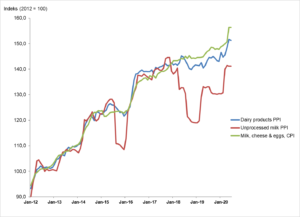
MPO POINTER 9/18 August 2020
The latest statistics for the producer price indexes (PPIs) of unprocessed milk and dairy products and the consumer price index (CPI) of milk, cheese, and eggs send a strong price signal that retail prices have risen significantly during the first six months of 2020 on the one hand, while on the other hand the price of unprocessed or raw milk (farm-gate price) has increased more slowly since August 2017, compared with the secondary and tertiary industries (graph 1). In fact, in August 2020 the producer price for unprocessed milk stood at the same level as in August 2017. The producer price for unprocessed milk is still lagging behind the other two indexes.
There is therefore no reason for the producer prices of unprocessed milk to fall now. The other two indexes have risen sufficiently to support the producer price of milk. However, dairy farmers need to ensure that they perform within their contract volumes and do not supply more milk to the market than is stipulated in their contract. Chasing volumes mostly leads to lower capital returns.
Graph 1: The PPI for unprocessed milk and dairy products and the CPI for milk, cheese, and eggs

Source: Statistics SA
The maintenance of current producer prices is further illuminated by the rise in the value of retail sales of dairy products over the first six months of 2020, compared with the corresponding period in 2019 (table 1). The retail market has succeeded in raising both the price levels and the volume of sales of most dairy products, as monitored by AC Nielsen.
These percentages, therefore, reflect the combined effect of increased sales volumes and rises in product prices. What makes this achievement all the more unique is that it took place mainly during the lockdown. Furthermore, the retail trade succeeded in restricting price rises to between 0,6% (yoghurt) and 8,4% (cream cheese) in June 2020 when compared with June 2019. Long-life milk prices rose by 7,8% over the same period.
Table 1: Rand values of retail sales
| Product | Jan ’19 – Jun’19
R (000’000) |
Jan’20 – Jun’20
R (000’000) |
% rise in the value of sales |
| Long-life milk | 3 132 | 3 693 | +18% |
| Fresh milk | 1 764 | 1 717 | -3% |
| Flavoured milk | 396 | 377 | -5% |
| Yoghurt | 2 810 | 3 193 | +14% |
| Buttermilk | 1 160 | 1 337 | +15% |
| Prepacked cheese | 1 750 | 2 107 | +20% |
| Cream cheese | 208 | 231 | +11% |
| Butter | 555 | 636 | +15% |
| Cream | 398 | 470 | +18% |
Source: Nielsen, supplied by SAMPRO, with calculations by the MPO
AC Nielsen Marketing and Media supply information based on monthly surveys of retail sales of milk and dairy products. Wholesale sales and industrial sales, which account for a considerable share of total dairy sales, are not covered by the surveys.
The survey on long-life milk, flavoured milk, yoghurt, buttermilk, and prepacked cheese is carried out among the following types of retail outlets:
- Hypermarkets and supermarkets like Shoprite, Checkers, Pick ʼn Pay Supers, Pick ʼn Pay Family, Superspar and Woolworths (Foods);
- Convenience stores (Branded Superettes like Kwikspar, OK Foods, Sentra, Pick ʼn Pay mini, Score, Friendly, Shield (Retail), 7-Eleven and Forecourts);
- Urban Counter and Self Service stores; and
- Rural Independents.
In the case of fresh milk, cream, butter, and cream cheese, the survey is restricted to major stores, namely hypermarkets and supermarkets.
It is clear from the above that although the survey did not cover all products, it provides some revealing insights into what is happening in the dairy market. It is true that the sales of certain dairy products virtually came to a standstill during the lockdown as a result of factors like the closure of restaurants and fast food enterprises. However, the dynamics of the value chain were sufficiently sophisticated to channel the flow of unprocessed milk to products for which there was a higher consumer demand during the lockdown.
To sum up
It appears from the available statistics that dairy products have achieved or retained a distinctive place in the consumer’s shopping basket, despite difficult socio-economic circumstances and four successive quarters of negative economic growth.
There is more than one data set that justifies maintaining the current level of producer prices. If producer prices were to be reduced, it would simply be because role players lower down the value chain were in a position to do that unilaterally. There is no economic justification for a reduction.
Naturally it is important that the supply by producers should keep in step with the contract volumes planned for by the secondary industry. If additional unprocessed milk is produced and peddled around, this would simply lead to downward pressure on producer prices.
Bertus van Heerden, chief economist, Milk Producers’ Organisation (MPO)
Published on Tuesday, 18th August 2020 - 12:43
Recent Posts
disclaimer









